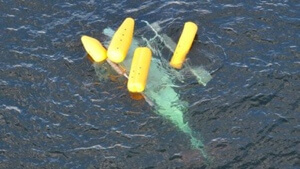
Helo with flotation deployed (katc.com)
It’s a beautiful March day 300 feet or so above the Gulf of Mexico. Why does it so often start with “beautiful day”? The weather is clear, but just a little breezy. 30 knots worth.
Today’s flight is fairly standard. Some light cargo and a few passengers to move. Just two passengers on board this leg between oil platforms. The headwind is making the transit to the next platform around 25 minutes instead of a more typical 15, but it’s not a problem. Plenty of fuel reserve and the southerly wind will get our pilot home safe and on time. Careful, wind is not just about transit time, especially in a helicopter.
There’s the next destination. It feels like it’s taking forever to get there with only about 35 knots of ground speed. He knocks out the landing checklist so it’s one less thing to think about on approach. The helo pad on this platform can only be approached from the southwest quadrant of the compass. Considering the south-southeast wind, the Bell 206B pilot decides he will have either a tailwind or crosswind for landing.
I have created a graphic to make this easier to follow. Airspeeds and ground speeds are estimates. Wind speed is from the report. No laughing at my cartoon. At least I didn’t attempt to hand draw something and then scan it. More explanation is included as we go. 0320_Bell_206_Brazos_542.pdf
He sets up for a crosswind approach and landing by circling to the right around the oil platform. In other words, he is turning the long way around from a southerly heading to an easterly one. For you fixed wing guys, the command seat in a helo is the right instead of the left. The reason why seems to be lost to history. A right turn keeps the landing point in sight.
As the 206B turns, two things happen:
- Airspeed drops as the aircraft turns out of the wind. Momentum is more about ground speed than airspeed and 3000 or so pounds of helicopter can’t change momentum very quickly. Airspeed would come back up if the turn was in cruise flight, but this is a decelerating turn for landing.
- Wind pushes the helo toward the landing point on downwind leg and tries to add ground speed on the base leg. Translation: A tight turn will be required to avoid overshooting final.
In the turn from base to final, the nose suddenly swings to the right and the aircraft spins. Left pedal (more anti-torque) has no effect. The pilot reduces power (torque) and lowers the nose (airspeed) in an attempt to fly out of the spin. The aircraft loses altitude as it spins and the pilot pulls in power at just before impact with the water to soften the landing.
As the helo was making the turn, ground speed had to come down to avoid overshooting or being too fast on final. Aerodynamically, he is in a hover out of ground effect or HOGE. Even at 0 airspeed, ground speed is 30 kts on the base leg because the wind is pushing the aircraft. (For the fixed wing guys, ground effect provides essentially the same benefit for rotary wing as fixed wing aircraft. More importantly, rotor tip vortices are recycled in a hover condition, increasing power required over what is needed for forward flight. Bottom line, this was a high power/torque condition.)
Being in a HOGE is not really a big deal, provided there is an adequate power margin. The issue here was the relative wind of 20 kts or so from about the 4 o’clock position. As you can see in the graphic, the wind is right in the middle of the critical relative wind area. Within this arc, the tail rotor effectiveness is reduced because it has more difficulty getting a good bite of air for anti-torque and because the helo wants to weathervane into the wind.
Bell 206B3 N5002E crashed of Gulf of Mexico oil platform BRAZOS 542 on March 20, 2000. Injuries to the pilot and 2 passengers were minor. The aircraft was destroyed.
AC -90-95 Unanticipated Right Yaw in Helicopters discusses Loss of Tail rotor Effectiveness (LTE) at length.
How would you have set up differently for this landing?
Note: The included photo is not from this incident.
